Essential Equipment for Dignified Care
A mortuary lift table is specialized equipment designed to safely lift and transport deceased individuals in funeral homes, morgues, and crematoriums. These tables improve workplace safety while ensuring dignified handling of remains.
Quick Guide to Mortuary Lift Tables:
| Type | Load Capacity | Power Source | Best For |
|---|---|---|---|
| Manual | Up to 2,500 lbs | Foot-pump hydraulics | Locations with limited power access |
| Electric | 1,000+ lbs | 12V battery/electric | High-volume facilities |
| Hydraulic | 1,000+ lbs | Hydraulic system | Precision lifting needs |
Investing in a quality mortuary lift table is one of the most crucial decisions for funeral home directors and mortuary operators. Since 1955, these specialized tables have evolved to address the unique challenges of mortuary operations, combining respect for the deceased with practical workplace safety considerations.
When selecting a mortuary lift table, consider three essential factors:
- Load capacity - Most tables handle 1,000+ lbs, with manual options supporting up to 2,500 lbs
- Operational mechanism - Choose between manual (foot pump), electric, or hydraulic systems
- Safety features - Look for braking systems, stable construction, and secure lifting mechanisms
"Our quality is held to the highest standards in the industry, and our innovations enable you to provide services with dignity and ease," notes one long-standing manufacturer with over 10,000 units in operation across funeral homes nationwide.
The right mortuary lift table not only reduces physical strain on staff but also streamlines operations by integrating with other mortuary equipment like refrigeration units and transport systems.
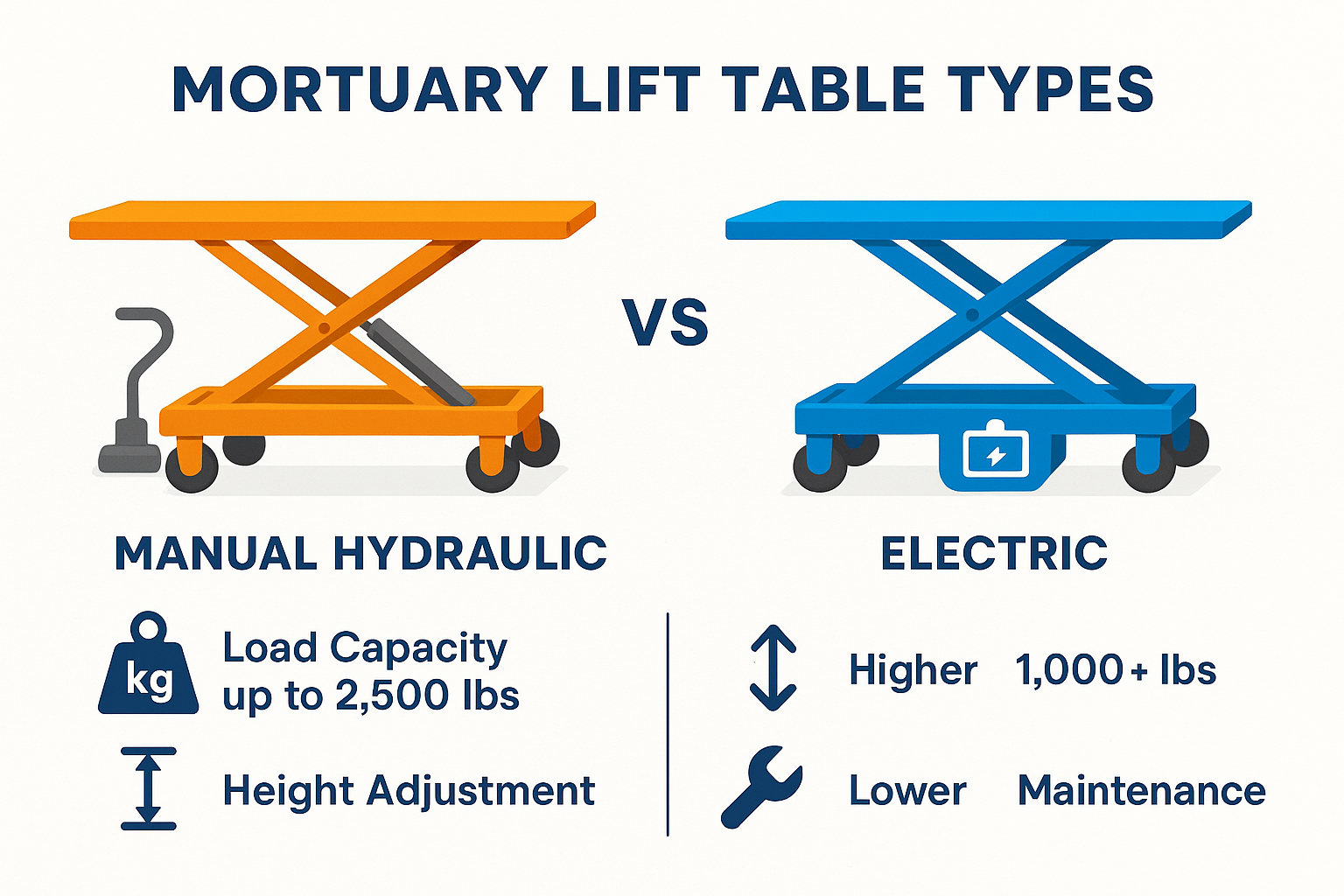
Mortuary lift table word guide:
Understanding Mortuary Lift Tables
When you step into a funeral home or morgue, there's a quiet dignity that should accompany every aspect of care for those who have passed. Behind the scenes, dedicated professionals rely on specialized equipment to maintain this respect while ensuring their own safety. At the heart of this equipment is the humble yet essential mortuary lift table.
What Is a Mortuary Lift Table?
A mortuary lift table is much more than just a platform with lifting capabilities. It's a carefully engineered piece of equipment designed specifically for the funeral industry, allowing funeral directors and mortuary staff to handle deceased loved ones with the care and respect they deserve.
Think of a mortuary lift table as the foundation of dignified care in the preparation room. Unlike standard industrial tables, these specialized platforms enable gentle and secure movement of the deceased during each stage of the preparation process.
The beauty of a mortuary lift table lies in its versatility. Staff can easily transfer remains between different areas without strain or risk. With smooth elevation control, professionals can adjust working heights to prevent back injuries while ensuring precise care. During preparation procedures, these tables provide the stability needed for meticulous work. And when it's time for final placement, they facilitate gentle transfer into caskets or cremation containers.
For many funeral homes, these tables have become indispensable tools that honor both the living and the deceased through thoughtful design.
Benefits of Using Mortuary Lift Tables
When funeral homes and morgues introduce mortuary lift tables into their operations, the positive impacts ripple throughout the entire facility.
First and foremost, these tables transform daily workflows. What once required multiple staff members gathering to move a deceased individual can now often be handled safely by a single person. Preparation processes become more efficient as transitions between different stages of care happen seamlessly. Time saved on logistics means more time for personalized attention to details that matter to families.
The health benefits for staff cannot be overstated. Mortuary lift tables dramatically reduce the physical toll of mortuary work. Back injuries from manual lifting—once considered almost an occupational hazard—become largely preventable. The stable support during handling procedures means fewer accidents and less physical strain over a career.
"I used to go home with an aching back every night," shares Michael, a funeral director with 15 years of experience. "Since we invested in our mortuary lift table, those days are behind me. I can focus on serving families instead of worrying about whether I'll be able to stand up straight tomorrow."
Perhaps most importantly, these tables improve the dignity afforded to those in your care. The smooth, controlled movements prevent any risk of mishandling. Proper positioning is maintained throughout transfers, ensuring that even when no family members are present, their loved one is treated with the same gentle respect you would want for your own family member.
In the funeral profession, where every detail matters, a quality mortuary lift table stands as a testament to your commitment to excellence—both for the families you serve and the dedicated professionals who work in your facility.
Types of Mortuary Lift Tables
When selecting a mortuary lift table for your facility, understanding the different types available is crucial to making an informed decision. Each type offers distinct advantages and operational characteristics suited to different funeral home or morgue environments.
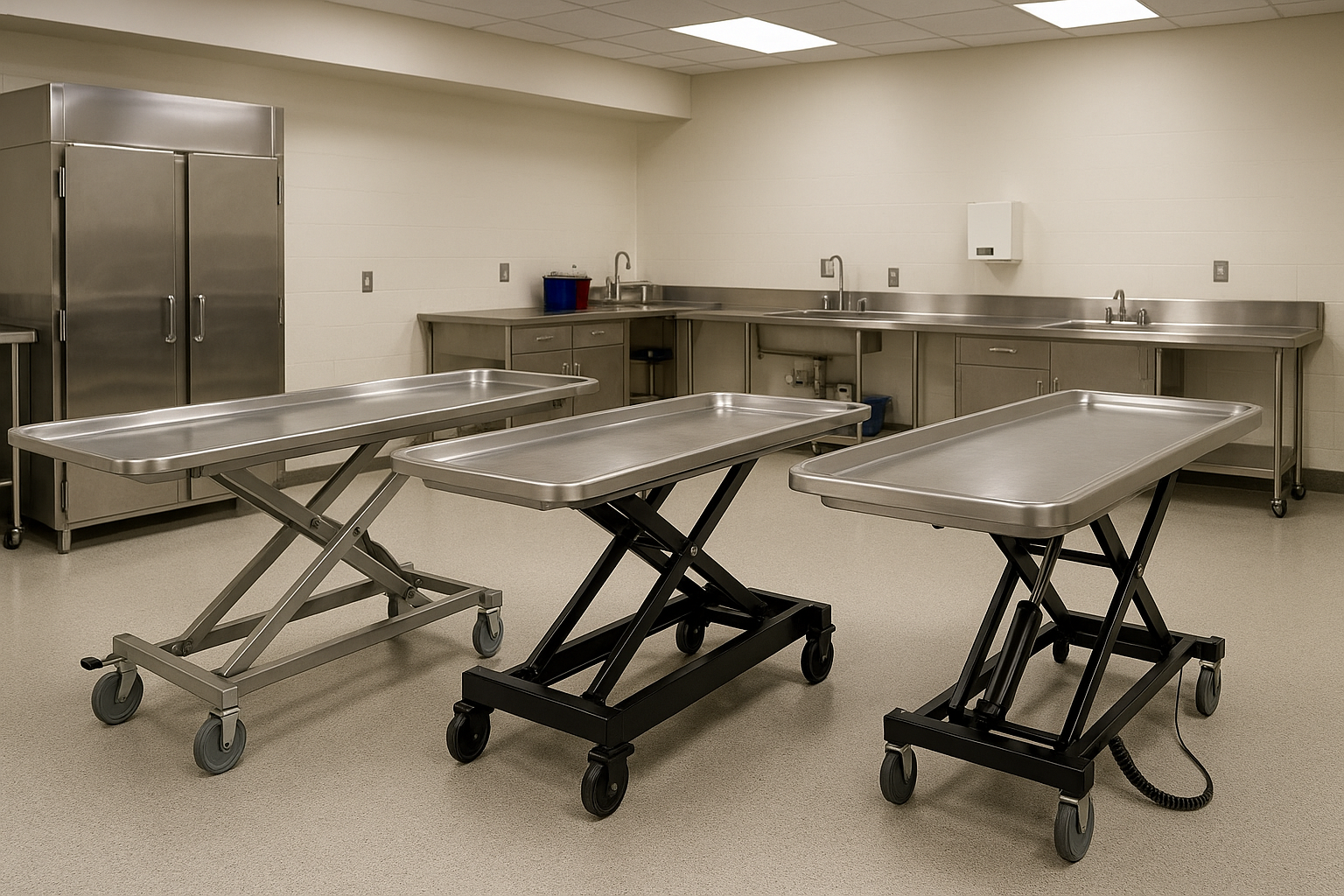
Manual Mortuary Lift Tables: An Overview
Manual mortuary lift tables are the workhorses of the funeral industry. They're straightforward, reliable, and don't need to be plugged in – perfect for facilities that value simplicity and independence from power sources.
These tables operate through a foot pump mechanism that activates a hydraulic system. This clever design keeps the operator's hands free to carefully position and stabilize the deceased, which is especially important during delicate transfers.
One of the biggest advantages of manual lift tables is their cost-effectiveness. They typically require a smaller initial investment than electric models, and their ongoing operational costs are minimal. With fewer moving parts and electronic components, maintenance is straightforward and issues are easier to diagnose and fix.
Perhaps most importantly, manual mortuary lift tables continue to function during power outages. As one funeral director from rural Tennessee told us, "Our manual lift table has been a lifesaver during storms. When the power goes out, we can still provide dignified care without missing a beat."
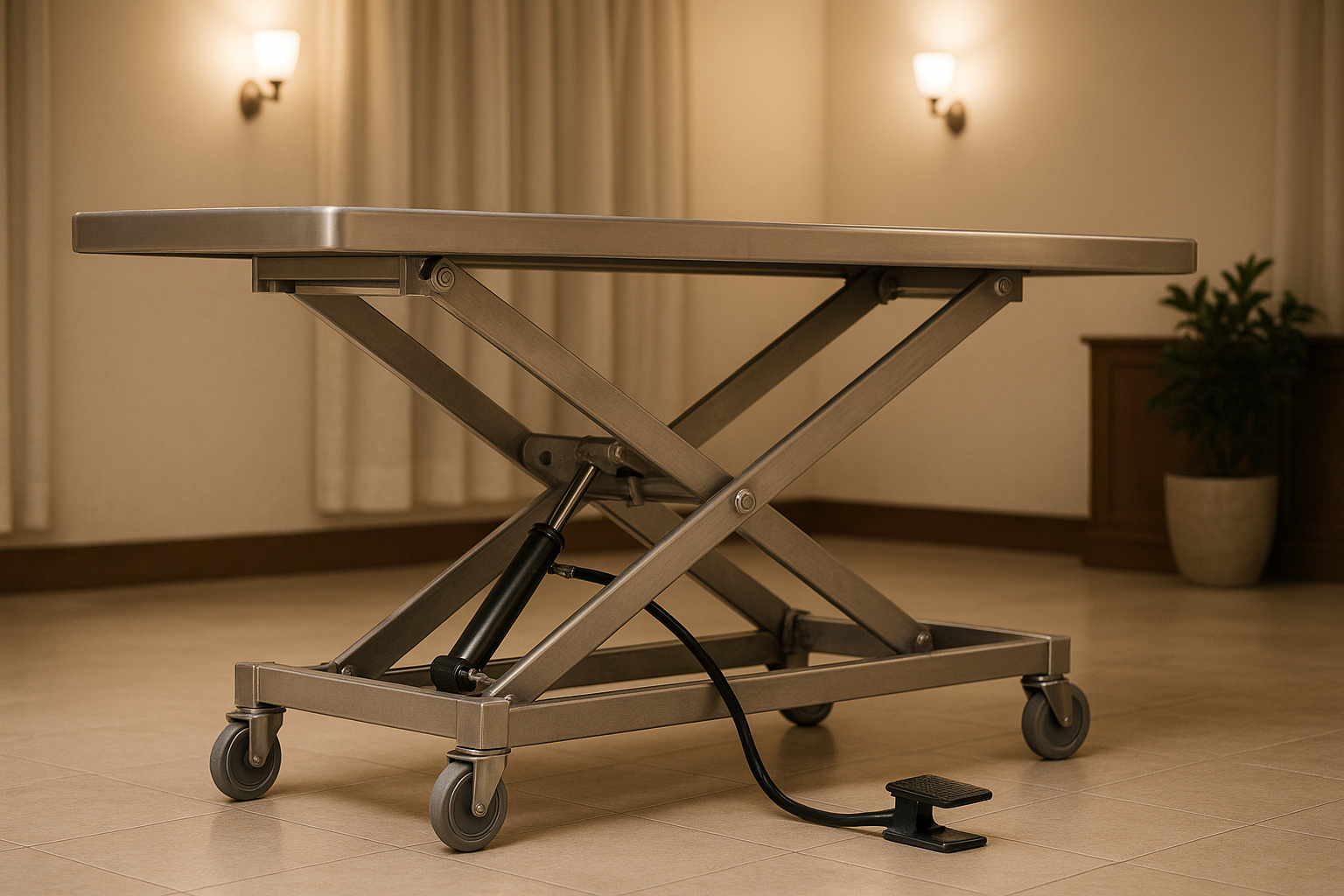
Despite their simplicity, these tables are impressively powerful. Many models can handle loads up to 2,500 pounds, more than enough capacity for even the most demanding situations. Their reliability is legendary in the industry – with proper care, a quality manual lift table can provide decades of dependable service.
Electric Mortuary Lift Tables: Advanced Mortuary Lift Table Options
For busier facilities or those looking to reduce physical strain on staff, electric mortuary lift tables offer improved functionality through powered operation. These systems typically combine hydraulic mechanisms with electric motors, often including a dedicated 12-volt battery for consistent performance.
The convenience of electric models is immediately apparent in daily use. With simple, intuitive button controls, staff can raise and lower the table with minimal physical effort. This allows them to focus more on providing dignified care rather than the mechanics of the equipment.
Many electric models include thoughtful additional features like multi-directional tops that make transfers smoother and easier. The Keller Manufacturing Battery-Powered Loading Table and Scale, for example, features a double scissor mechanism that makes inserting caskets into cremation chambers quick and effortless, while handling loads up to 1,000 pounds.
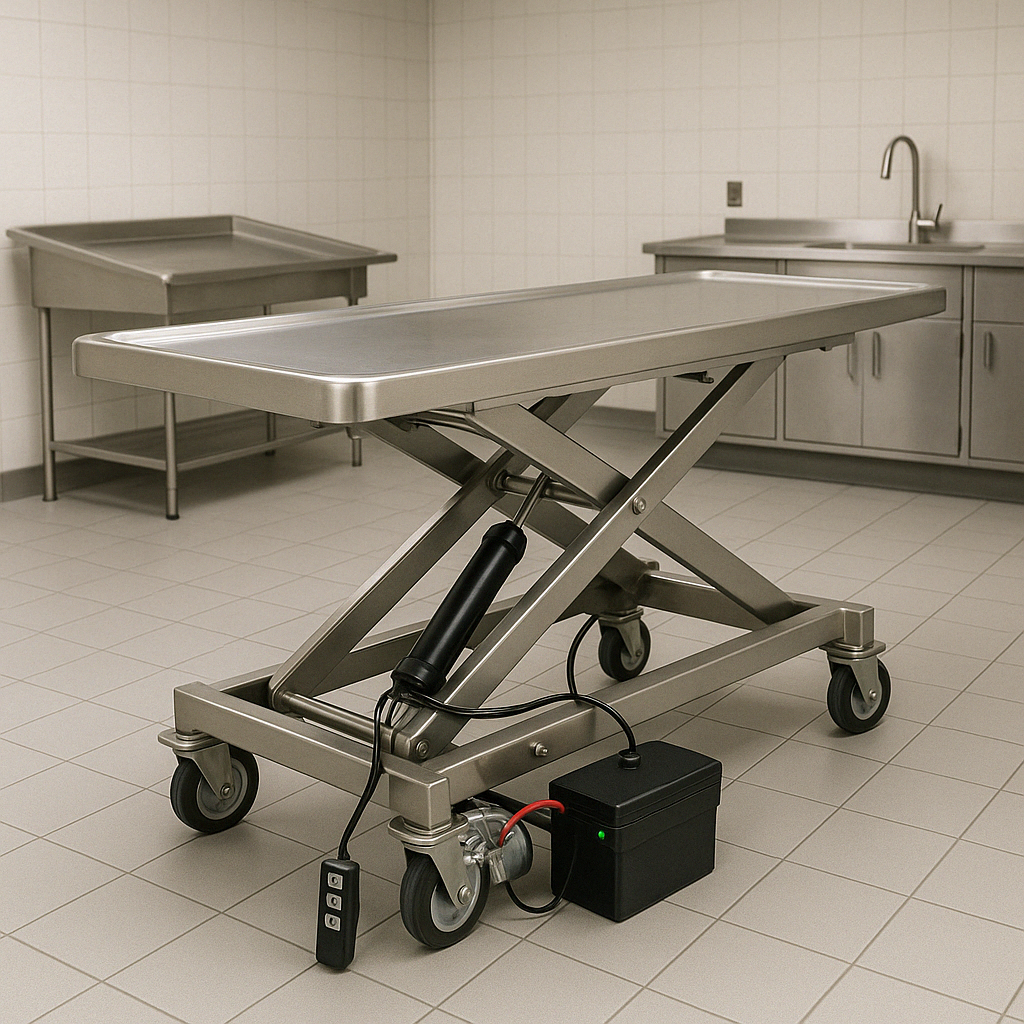
Electric tables do require more attention to maintenance than their manual counterparts. Regular checks of the battery, hydraulic fluid levels, and electrical components are necessary to ensure reliable operation. However, as our equipment specialist at American Mortuary Coolers notes, "We've seen a significant shift toward electric lift tables in larger metropolitan facilities. The reduced physical strain allows staff to focus more on compassionate care, which is what really matters in this profession."
Many funeral directors find that the convenience and ergonomic benefits of electric models more than justify the additional maintenance. And with battery backup systems, these tables can continue to function during power outages, providing the best of both worlds – convenience and reliability when you need it most.
Key Specifications to Consider When Choosing a Mortuary Lift Table
Shopping for a mortuary lift table can feel overwhelming with so many options available. But don't worry - I'm here to walk you through the most important features to consider. Think of this as your friendly guide to finding equipment that will serve your funeral home or morgue reliably for years to come.
Load Capacity and Height Adjustment
When you're investing in a mortuary lift table, two of the most crucial specifications are how much weight it can handle and how high it can lift.
Most funeral homes need tables that can support at least 1,000 pounds, but it's always wise to choose a model with about 20% more capacity than you think you'll need. This gives you a comfortable safety margin for unexpected situations. If your facility regularly serves bariatric cases, you might want to consider tables rated for 2,000 pounds or more.
Manual tables typically offer impressive strength - many can handle up to 2,500 pounds! Electric and hydraulic models usually support around 1,000 pounds, which is sufficient for most standard applications.
Height adjustment is equally important. A good mortuary lift table should lower to about 22 inches from the floor to make transfers from coolers easier, while extending up to 64 inches or higher for comfortable working height. This range accommodates staff members of different heights and various preparation procedures without causing back strain.
"Select lift tables that meet the specific load capacity and size requirements of your work environment," our equipment specialists often advise customers. "Think about both your current needs and what you might need in the future - this ensures you won't outgrow your equipment too quickly."
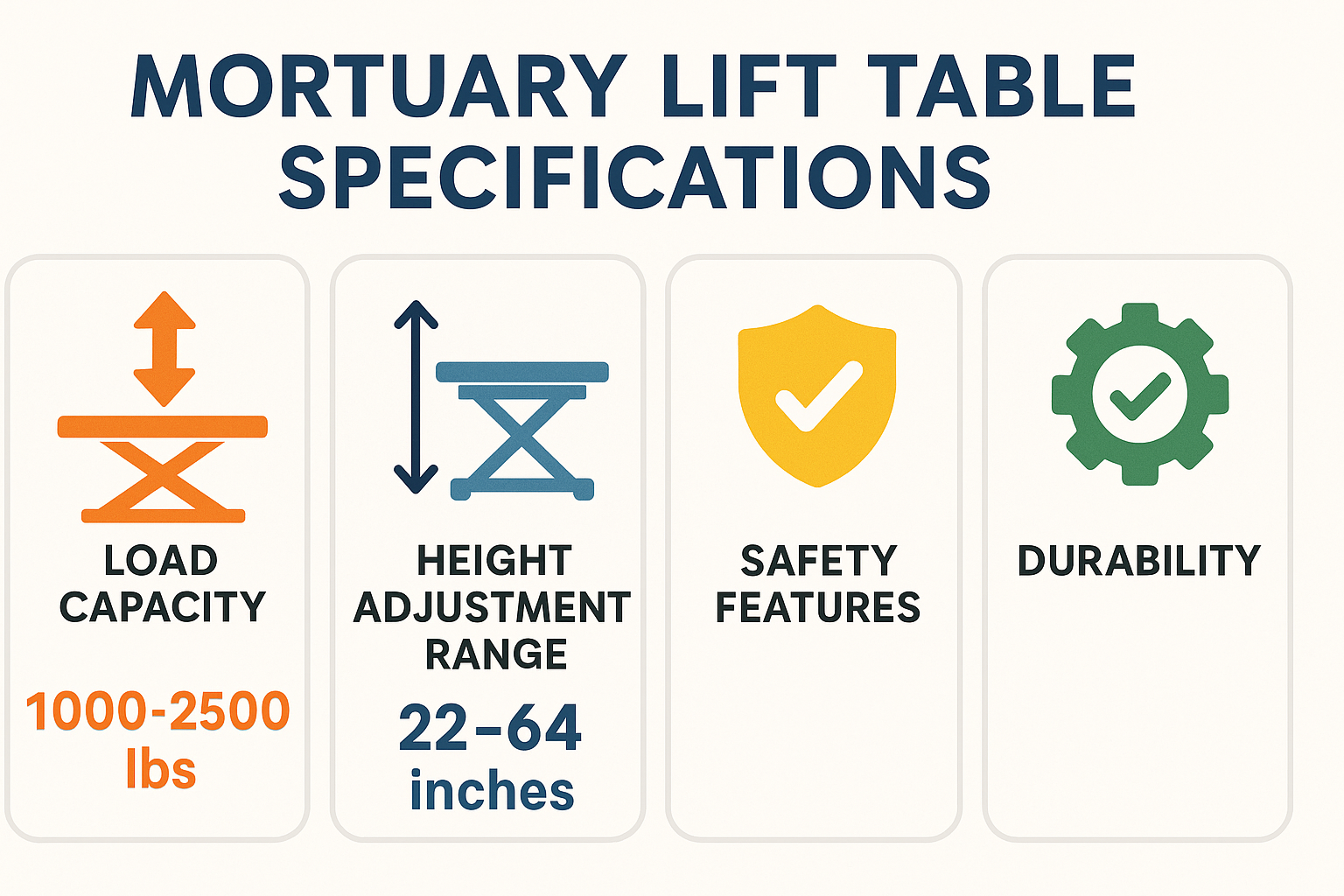
Safety Features and Design
The safety features of your mortuary lift table aren't just about preventing accidents - they're about ensuring dignified care for the deceased and protecting your staff from injury.
Look for tables with reliable braking systems at both the front and rear. Many quality models feature brakes operated by a simple red handle lever that locks the table firmly in place during critical procedures. The construction should feel rock-solid with no wobbling or tipping risk, even when fully loaded.
The hydraulic system should operate smoothly without jerking or sudden drops that could disturb the deceased. Secure locking mechanisms are essential to prevent unexpected movement when the table is positioned at a specific height.
Design details make a big difference in daily use. Some advanced mortuary lift tables feature tops with alloy wheels and spring-loaded pins, allowing for quick removal or exchange when needed. The surfaces should be non-porous and able to withstand regular exposure to disinfectants and mortuary chemicals without deteriorating.
Don't overlook maneuverability - even a well-designed table can become frustrating if it's difficult to move through doorways or position in tight spaces. The controls should be positioned where staff can easily reach them without awkward stretching or bending.
At American Mortuary Coolers, we've found that thoughtful design facilitates dignified handling through every step of the process, from transfers between equipment to preparation procedures.
Durability and Maintenance
A mortuary lift table represents a significant investment, so you'll want to choose one built to last. The durability of your table directly affects both your daily operations and long-term budget.
The most durable tables feature all-steel construction frames that can withstand years of heavy use. Look for powder-coated or stainless steel surfaces that resist corrosion, especially important in environments where cleaning chemicals are frequently used. The hydraulic cylinders, motors, and control systems should be industrial-grade components from reputable manufacturers.
Good design distributes weight evenly across the lifting mechanism, preventing stress points that could lead to premature failure. This thoughtful engineering makes a noticeable difference in the table's lifespan.
Maintenance shouldn't be complicated. Quality tables have easily accessible inspection points for checking hydraulic fluid, battery condition, and mechanical components. Before purchasing, ask about the availability of replacement parts - a well-established manufacturer will maintain a supply of components for their models.
"A quality mortuary lift table should provide trouble-free service for many years with only minimal maintenance," explains our service manager. "This typically includes regular cleaning, occasional lubrication of moving parts, and periodic inspection of hydraulic components."
Funeral homes across the country - from small-town Tennessee to busy Los Angeles - report that well-maintained lift tables often remain in service for 10-15 years or more. That longevity makes them one of the wisest equipment investments you can make for your facility.
When properly maintained, your mortuary lift table becomes a reliable partner in providing dignified care, day after day, year after year.
How Mortuary Lift Tables Improve Efficiency and Safety
Beyond their basic functionality, mortuary lift tables transform the daily operations of funeral homes and morgues in ways that might not be immediately obvious. They're not just pieces of equipment – they're workflow revolutionaries that create safer, more dignified environments for both the deceased and the professionals who care for them.
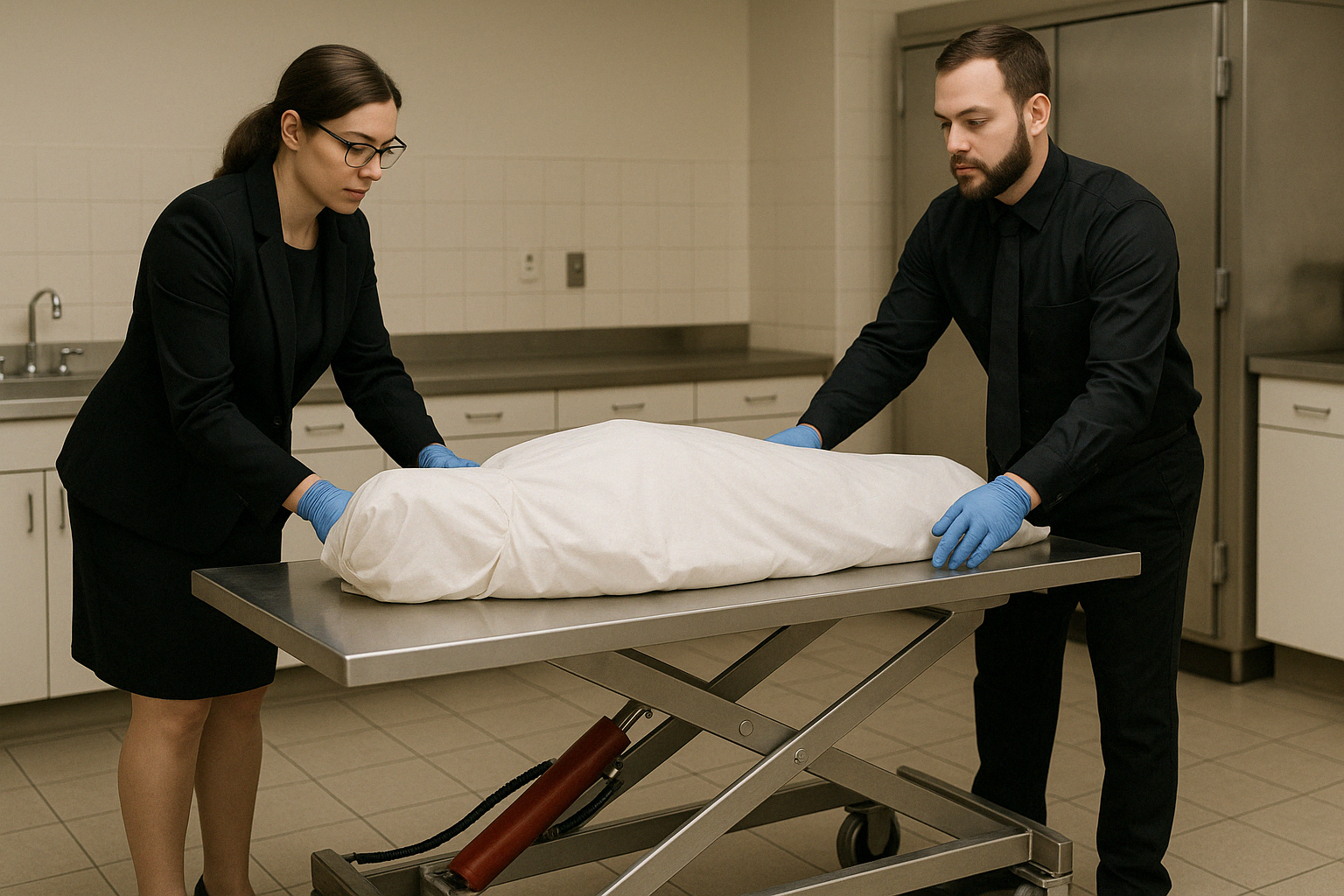
Improving Workflow in Funeral Homes and Morgues
Ask any funeral director who's made the switch to a quality mortuary lift table, and they'll tell you the same thing: "I wish we'd done this years ago."
The workflow improvements are immediately noticeable. Tasks that once required three or four staff members can often be handled safely by just one person. This isn't just about efficiency – it's about redirecting valuable human resources toward what matters most: caring for families during their time of need.
A funeral director in Dallas shared with us that after integrating an American Mortuary Coolers mortuary lift table into their operation, transfer times dropped by nearly 40%. That extra time went straight into providing more attentive family care and perfecting preparation details.
The dignity factor cannot be overstated. With a proper lift table, every movement is smooth, controlled, and respectful. The hydraulic systems provide gentle transitions that maintain the deceased's positioning, eliminating the sometimes jarring movements that can occur with manual transfers. This creates a more reverent atmosphere, even when no family members are present – because respect shouldn't depend on who's watching.
"In our profession, how we handle someone's loved one reflects our entire philosophy of care," one of our longtime customers told us. "When families entrust their loved one to us, they're placing enormous faith in how we'll care for them behind the scenes. A quality mortuary lift table ensures we honor that trust with every transfer."
For those interested in exploring more lifting options for their facility, we've put together a detailed guide on hydraulic body lifts and stretchers that complements this information.
Integration with Other Equipment
The true genius of a well-designed mortuary lift table reveals itself when you see how it works with your existing equipment. The best tables don't exist in isolation – they form the backbone of a cohesive care system.
At American Mortuary Coolers, we've designed our mortuary lift tables with this integration in mind. The height ranges are specifically calculated to align perfectly with our cooling units, creating seamless transitions that maintain dignity and safety throughout the care process.
Compatibility matters tremendously in this field. Your lift table should work harmoniously with your refrigeration units, allowing for smooth transfers without awkward height differences. It should integrate with your roller systems and trays, creating a continuous path of movement that minimizes handling. When these elements work together, the entire preparation process flows naturally from one stage to the next.
A mortuary in Chicago that implemented our fully integrated system reported not just improved efficiency, but also a remarkable reduction in staff fatigue and workplace injuries. The funeral director noted, "Our team used to dread certain aspects of transfers, especially with larger individuals. Now those concerns are gone – the equipment does the heavy lifting, and our staff can focus on the care details that make a difference to families."
The physical strain reduction is perhaps the most immediate benefit staff will notice. Back injuries are alarmingly common in funeral service – an industry where professionals often put their own well-being second to the needs of grieving families. A proper mortuary lift table addresses this directly by eliminating the need to manually lift and carry, protecting your most valuable asset: your dedicated team members.
When your equipment works together as a system rather than as individual pieces, the result is a more dignified experience for the deceased and a safer, more efficient workplace for your team. That's not just good business – it's good care.
Cost Considerations When Investing in a Mortuary Lift Table
When it comes to equipping your funeral home or morgue, a mortuary lift table represents one of the most significant investments you'll make. As with any major purchase, looking beyond the price tag to understand the full financial picture will help you make a choice that serves your business for years to come.
The initial investment for a quality mortuary lift table varies considerably depending on the type you choose. Manual models typically range between $1,500 and $3,000, offering a more budget-friendly entry point. If you're considering an electric model with advanced features, expect to invest between $5,500 and $7,000.
"We've had funeral directors tell us they initially experienced sticker shock, but after a year of use, they couldn't imagine operating without their lift table," shares our equipment specialist at American Mortuary Coolers. "The value becomes clear very quickly."
Beyond the base equipment cost, consider whether your new mortuary lift table will require professional installation or modifications to your facility. Some of our customers across Tennessee and beyond have found they needed minor adjustments to their preparation rooms to maximize the efficiency of their new equipment. Staff training also factors into your upfront costs, particularly for more sophisticated electric models.
Maintenance costs represent another important consideration in your budgeting process. Quality mortuary lift tables require regular attention to ensure safe, reliable operation. This typically includes periodic inspections of hydraulic systems, lubrication of moving parts, and occasional replacement of wear items. For electric models, factor in battery replacements every few years to maintain optimal performance.
The good news? When properly maintained, a high-quality mortuary lift table from American Mortuary Coolers typically provides 10-15 years of reliable service. This extended lifespan significantly improves your return on investment compared to lower-quality alternatives that might need replacement after just a few years.
Many funeral directors find that the productivity gains alone justify the investment. Tasks that once required multiple staff members can often be handled safely by a single person, freeing up your team to focus on other aspects of service. This efficiency translates directly to your bottom line.
Perhaps most importantly, a proper mortuary lift table dramatically reduces the risk of workplace injuries. Back strains and other lifting-related injuries not only cause pain for your staff but can lead to significant costs through workers' compensation claims, increased insurance premiums, and lost productivity.
"One of our customers in Johnson City calculated that preventing just one serious back injury paid for their new lift table," notes our sales manager. "That's before considering the improved dignity in handling they were able to provide families."
At American Mortuary Coolers, we understand that equipping a funeral establishment involves careful financial planning. That's why we offer several budgeting strategies to help make this investment more manageable. Many of our customers opt for phased implementation, starting with one high-quality mortuary lift table and adding more as their budget allows. We also provide flexible payment options to distribute the investment over time, making it easier to acquire the equipment you need without straining your cash flow.
Remember to consult with your accountant about potential tax advantages for equipment investments. Depending on your situation, you may qualify for deductions that significantly reduce the effective cost of your new equipment. Some funeral homes have even found regional business development programs that offer grants for workplace safety improvements.
We're committed to helping you find solutions that meet both your operational needs and budget constraints, whether you're located just down the road from us in Tennessee or across the country in California. A mortuary lift table isn't just an expense—it's an investment in your staff's wellbeing and the quality of care you provide families during their most difficult times.
Frequently Asked Questions about Mortuary Lift Tables
We've helped hundreds of funeral homes find the perfect equipment over the years, and certain questions about mortuary lift tables come up time and again. Let's address the most common ones we hear from funeral directors across the country.
What Are the Typical Load Capacities of Mortuary Lift Tables?
When funeral directors call us about mortuary lift tables, load capacity is often their first concern—and with good reason. The last thing anyone wants is equipment that isn't up to the task.
Most standard electric mortuary lift tables come rated for about 1,000 pounds, which handles the vast majority of situations comfortably. If your facility regularly works with bariatric cases, you might want to consider our heavy-duty electric models that support up to 1,500 pounds.
Many funeral homes are surprised to learn that manual hydraulic models often offer the highest capacity—up to 2,500 pounds in some cases. The Keller Manufacturing Battery-Powered Loading Table, which many of our customers love, provides a solid 1,000-pound capacity that works well for most funeral homes.
I always recommend choosing a table with at least 20% more capacity than you think you'll need. This gives you a safety buffer and helps extend the life of your equipment. As one of our customers in Memphis told me, "It's better to have it and not need it than need it and not have it."
How Do Manual and Electric Mortuary Lift Tables Differ?
The choice between manual and electric mortuary lift tables often comes down to your specific working conditions and preferences.
Manual tables use a foot-pump hydraulic system that requires some physical effort but gives you complete independence from power sources. They're typically more affordable upfront and simpler to maintain since there are fewer components that could potentially fail. Many of our rural customers prefer these for their reliability during power outages.
Electric tables, on the other hand, do all the heavy lifting for you at the touch of a button. They raise and lower more quickly and with much less physical exertion, which is a blessing during a busy week. The trade-off is that they require more maintenance—regular battery checks, electrical system inspections, and hydraulic fluid monitoring.
One funeral director in Nashville switched from manual to electric and told me, "My back thanks me every day for making the change." But another in rural Montana prefers manual, saying, "In a blizzard with no power, I can still take care of families without skipping a beat."
What Safety Features Should I Look For in a Mortuary Lift Table?
Safety isn't just a feature—it's the foundation of good equipment design, especially when it comes to mortuary lift tables. Here's what matters most:
A reliable braking system tops the list. Look for tables with dual brakes (both front and rear) that lock securely in place. Many of our premium models feature a red handle lever brake system that stops the table immediately with one simple motion.
Stability is crucial when you're fully extended at maximum height. A wide, heavy base prevents tipping, even when the table is raised to its highest position. This isn't just about protecting staff—it's about maintaining the dignity of those in your care.
The hydraulic system should operate smoothly, without jerky movements or sudden drops that could startle staff or disturb the deceased. Quality hydraulics move steadily and predictably, giving you complete control.
For electric models, an emergency lowering capability is essential. Even during power failures, you need to be able to safely lower the table to continue your work.
As Tom, a funeral director in Chicago who's been using our equipment for years, put it, "These safety features aren't just nice-to-haves. They're what let me sleep at night knowing my staff is protected and our families are getting the respectful care they deserve."
At American Mortuary Coolers, we believe that when you're confident in your equipment's safety, you can focus completely on providing compassionate care—which is what families remember most.
Conclusion

Choosing the perfect mortuary lift table isn't just about buying equipment—it's about investing in the heart of your funeral service operations. Throughout this guide, we've walked together through the various options and considerations that make this decision so important for the families you serve.
When you select the right mortuary lift table, you're choosing more than metal and hydraulics. You're choosing peace of mind. You're ensuring that every person in your care receives the same gentle, dignified handling they deserve in their final journey.
Here at American Mortuary Coolers, we've helped funeral directors from small-town Tennessee to busy Los Angeles facilities find their perfect equipment match. We've seen how the right table transforms not just operations, but also the confidence and wellbeing of staff members who use it daily.
Remember to consider your unique situation when making your selection. The volume of cases you handle, the physical layout of your preparation area, and even the typical build of those in your care should influence your decision. A busy urban facility might benefit from an electric table's efficiency, while a rural funeral home might appreciate the reliability of a manual system during power outages.
Safety features should never be an afterthought. Those stable braking systems and smooth hydraulic operations aren't just specifications on paper—they're what prevents accidents and preserves dignity during those critical moments of transfer and preparation.
We've found that funeral directors who think long-term end up most satisfied with their purchase. Quality construction might come with a higher price tag initially, but when that table is still performing flawlessly a decade later, the value becomes crystal clear. As one of our customers in South Carolina told us, "I've never regretted buying quality, but I've certainly regretted trying to save a few dollars on essential equipment."
Integration with your existing systems matters tremendously. Your mortuary lift table should work in harmony with your coolers, preparation stations, and other equipment. This seamless workflow isn't just about efficiency—it's about creating a respectful environment where every movement is purposeful and controlled.
"The difference between struggling with inadequate equipment and working with tools designed specifically for our needs is night and day," shared a funeral director from Tennessee. "With the right lift table, I can focus completely on providing care rather than fighting with equipment."
At American Mortuary Coolers, we take pride in crafting durable, custom mortuary lift table solutions that arrive directly at your door, anywhere across the contiguous 48 states. Our commitment isn't just to sell equipment—it's to become your partner in providing dignified care, year after year.
For more information about how our complete range of mortuary solutions can improve your service offerings, please visit our comprehensive guide to mortuary equipment.
We understand that behind every technical decision is a commitment to serving families with compassion and respect. We're honored to help you fulfill that commitment with equipment worthy of your calling.
















